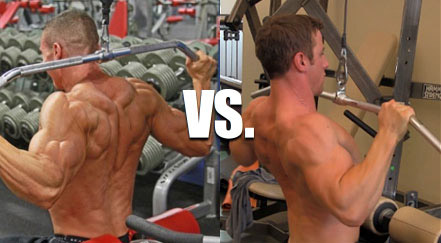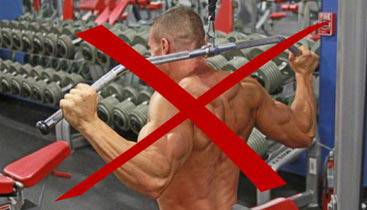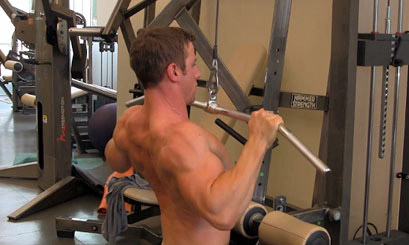BEHIND THE NECK LAT PULLDOWN VS. IN FRONT

Sure, we’ve probably see plenty of people do lat pulldowns in the gym. But do those performing a behind the neck lat pulldown know something we don’t?
There’s no question that lat pulldowns are an excellent movement for stimulating the lats and building up overall back width and thickness.
Every well-rounded back training routine should include a basic vertical pulling movement of some kind, whether it be some variation of the lat pulldown or the chin-up. (These two exercises utilize the same basic movement pattern, so either one will be highly effective.)
There are many different lat pulldown variations you can choose from, including the use of different grip widths, attachments, and torso positioning.
In this post, I’m going to specifically discuss the issue of where the bar should be pulled to, whether it be behind the neck or in front of the neck.
Lat Pulldowns Behind The Neck Vs. In Front
In the same way that I recommend you always perform overhead pressing either in front or to the side of your neck in order to protect yourself from injury (I discussed this in detail in a previous post), the same advice applies here as well.
When it comes to performing lat pulldowns, always pull the bar down in front of your neck to your upper chest.
There are a few main reasons why behind the neck pulldowns aren’t the best choice…
Increased Risk Of Shoulder Injury – First off, performing lat pulldowns with your arms behind your head puts your shoulder into an excessive position of external rotation. This places your rotator cuff muscles (particularly the subscapularis) into an overly stretched position, preventing them from properly supporting the shoulder joint and increasing the risk of shoulder injury.
Excessive Stress On The Spine – Secondly, since most people don’t have the proper flexibility to pull the bar down in a straight line, they end up excessively protruding their head forward, which places a dangerous amount of stress on the cervical spine.
Promotes Forward Head Posture – Thirdly, behind the neck pulldowns promote bad motor patterning by encouraging forward head posture, which can easily lead to shoulder and back problems, among other issues.

Now, let me make something clear here…
I’m not saying that behind the neck pulldowns are guaranteed to cause injury or that every single person who performs them is going to run into problems.
If you have good shoulder flexibility, use moderate weights, and perform the lift under strict control, there’s a decent chance that they won’t cause any noticeable issues for you.
However, given that performing your lat pulldowns to the front is a natural movement pattern for the human body (when was the last time you saw someone climb something and pull it behind their head?), and that it fully stimulates your lats without placing your neck, shoulders, and spine into a vulnerable position, why bother taking the risk?
Behind the neck pulldowns offer no additional muscle building advantage that lat pulldowns to the front don’t, and yet they do present the very real downside of an increased risk for injury.
Every single exercise you perform in the gym has a ratio of risk-reward attached to it, and if your goal is to maximize your muscle gains and ensure that remain injury free over the long haul, you need to choose your lifts and training methods based on what tips that ratio most in your favor.
My recommendation is to perform your lat pulldowns with an overhand grip, hands spaced 1-2 inches outside of shoulder width, torso angled slightly back, and pulling the bar in front of your neck to your upper chest.

This variation will allow you to train your lats with full effectiveness while keeping your shoulders, neck, and spine protected at the same time.
If you want to see a detailed video demonstration of the exact form that I recommend, check out this video.
If you found this article helpful, make sure to sign up for your FREE custom fitness plan below...




